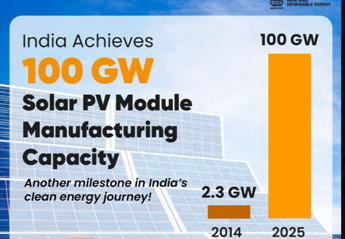

14th August 2025 (13 Topics)
Context:
The Prime Minister Shri Narendra Modi today hailed the milestone towards self-reliance in achieving 100 GW Solar PV Module Manufacturing Capacity and efforts towards popularising clean energy.
Potential of Solar Energy in India
- The National Institute of Solar Energy (NISE) estimates a theoretical potential of 748 GW, just 3% of wasteland is covered by PV modules.
- As of June 2025, India’s installed solar capacity is 9 GW, which is only ~14.8% of the total potential — indicating vast untapped resources.
- Achievement: 100 GW installed solar PV module manufacturing capacity enlisted under Approved List of Models and Manufacturers (ALMM).
- Previous Level (2014): Only 2.3 GW.
Current Status and Global Ranking
- India ranks 3rd globally in installed solar capacity and 4th in total renewable energy capacity.
- Total renewable energy capacity stands at 186.46 GW (excluding large hydro), while total non-fossil fuel capacity is 235.7 GW — about 49% of the total 476 GW installed capacity.
- This puts India nearly halfway towards its COP26 500 GW non-fossil capacity target for 2030, five years ahead of schedule.
Contribution to Climate and Energy Goals
- Solar expansion supports India’s Nationally Determined Contributions (NDCs) under the Paris Agreement — reducing emissions intensity by 45% from 2005 levels by 2030.
- India added 83 GW solar capacity in FY 2024–25, the highest annual addition ever, reflecting strong policy and investment push.
Factors Driving Growth
- Geographical Advantage: ~300 sunny days/year; 4–7 kWh/m²/day average solar irradiation.
- Government Programs:
- PM Surya Ghar: Muft Bijli Yojana – 10.09 lakh rooftop installations achieved by March 2025.
- PM-KUSUM Scheme – targets 30.8 GW in agricultural sector; decentralised solar deployment rising steadily.
- 100% FDI allowed in the sector; ISTS fee waiver for projects commissioned by June 2025 has boosted cross-state trade.
- International Leadership: Through International Solar Alliance and partnerships like the Indo-German Solar Energy Partnership (IGSP).
Persistent Challenges
- Land Use: Solar requires ~300× more land than nuclear (Economic Survey 2023–24). Large-scale projects risk conflict with agriculture and biodiversity.
- Grid Integration & Storage: Integrating 110+ GW solar with variable generation is straining transmission infrastructure.
- Domestic Manufacturing Gaps: Despite PLI schemes, India still imports significant quantities of modules, cells, and inverters.
- Environmental Concerns: Mining for Lithium, Cobalt, and rare earths generates ~15 tonnes CO? per tonne of mineral and consumes high water.
Way Forward
- Grid Modernisation: Deploy smart grids and microgrids to manage peak load and variable generation.
- Land Efficiency: Promote agrivoltaics and floating solar to reduce land conflicts.
- Domestic Supply Chains: Strengthen R&D and manufacturing through PLI and Make in India to reduce import dependence.
- Circular Economy: Establish solar panel recycling infrastructure to recover critical minerals before large-scale panel retirement in the 2040s.
- Hybrid & Tech Integration: Combine solar with wind, storage, AI, and IoT for optimised energy generation and consumption.


